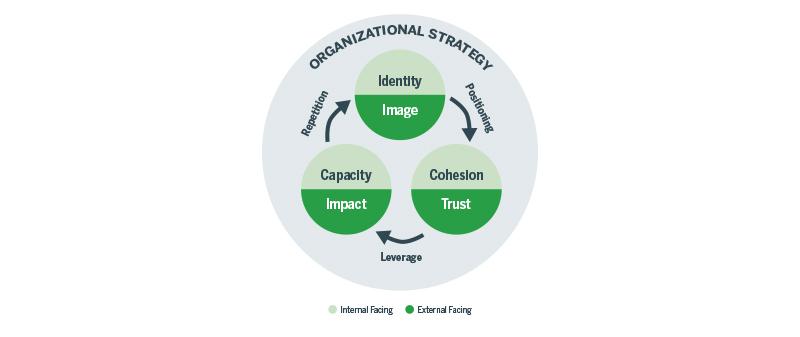It takes great focus and clarity for brands to rise above the din of the crowd and be heard in today’s information-saturated world. And for nonprofit brands, the challenge is even greater. Because when the message is about a better future, possibly somewhere far away, mission-driven brands have an extra challenge that for-profit brands usually don’t—creating urgency to act on issues that may seem far removed from our lives. The issues can be complex and difficult to understand or embrace. And when the size of the lift seems so big, nonprofits need to use communications effectively to demonstrate tangible progress and results if they are to sustain our engagement.
Fortunately, new thinking in nonprofit brand experience in recent years offers both the insights and motivation needed to take on these intertwined challenges. The continued growth of digital communications, the maturation of the design field as an essential problem-solving discipline, and a recent awakening within many nonprofits about the value of their brand have combined to provide new opportunities to increase the effectiveness of the nonprofit sector. The challenge, then is to understand the environment in which social change brands exist and apply this understanding to help us design nonprofit brand experiences that deliver greater value and maximize impact.
The Rise of Brand in the Nonprofit Sector
It’s no secret that over the years, brand has had a bit of a tortured existence in the nonprofit sector. However, more nonprofits are getting past their brand skepticism (if not outright resistance), and have thankfully been re-examining their relationship with “The B-word.” By making smart adaptations to traditional business-centric brand principles, organizations such as The Harvard Kennedy School of Government, Stanford Social Innovation Review, and The Communications Network have contributed to help evolve the role of brand within nonprofits; developing a mission-driven, participatory framework more in keeping with the sector’s values.
This new way of thinking, articulated in Nathalie Laider-Kylander’s and Julia Shephard Stenzel’s landmark book, The Brand IDEA: Managing Nonprofit Brands with Integrity, Democracy, and Affinity, is perhaps summarized best in its introduction by Christopher Stone, President of Open Society Foundations: “A brand is a powerful expression of an organization’s mission and values, that can help engineer collaborations and partnerships that will better enable it to fulfill its mission and deepen impact, and it’s a strategic asset essential to the success of the organization itself.”
Understood this way, a nonprofit’s brand offers the potential for far more than just good messages and visuals. It’s the DNA of a social change organization’s ideas, expertise, relationships, resources, and experiences, and guides organizational culture by bringing people together around a shared vision to make it easier to create shared value.
If we accept this idea—and we should—then we must also consider how social change organizations can most effectively translate brand nuance and complexity into something more tangible. How can we create experiences that make it easier and more enticing for people to participate in creating this shared value? And more important, how can we make sure that our solutions continuously maintain the integrity of our brand and deliver meaningful experiences that sustain audience engagement?
Translating Organizational Strategy
It can be daunting to fully understand what some nonprofits do—not just for the outside world, but sometimes even for those who work inside them! Countless activities and moving parts all work together to advance a mission. But how do they relate to one another, and to what ends? Brand strategy has long been a useful tool for helping organizations increase clarity and focus to help an organization better understand itself and its audience. Done right, it provides an important foundation for expressing mission, vision, values, and key messages with greater consistency.
For social change organizations, many of whom take on complex, systemic challenges where progress may be more difficult to see, brand strategy has an even bigger role to play. It must also connect people more deeply to how change actually happens. It must help social change brands educate us on the nature of the challenges, detail the different roles they play in addressing them, and explain how we can work together and what to expect along the way. This calls for a brand narrative that creates a strong through-line from mission success all the way through to engagement.
The benefits of a process that creates a clear brand strategy to articulate a narrative this nuanced are profound when it comes to organizational strategy. The risk is that months of discovery and self-analysis produce useful strategy that sits on a shelf and is not properly integrated into an organization so that it is felt at every level of experience people have with the brand.
So how do brands make these abstract concepts and processes more tangible, meaningful and valuable? Well, as branding expert Marty Neuimeir says, this means “you gotta design.”
Design, Value, and Meaning
Think about how much of our existence is built on design. There’s a reason humans live in such a thoroughly designed world—we’re highly visual creatures and design is how we make sense of it! Countless designed experiences every day, many of which we are barely aware of, create context and connect with our emotions, greatly affecting our perception of value, and therefore meaning. And design—both its process and its outcomes—is all about relationships and context.
Brands themselves are one of these designed constructs. Dating as far back as our use of heraldry to self-identify with a tribe or clan, brands are powerful concepts that help give greater meaning to our lives. In many ways, they encapsulate what we value, and conversely, what we do not value. And as the design discipline is all about working in context, for modern brands to design experiences that connect with these deeper feelings of value and meaning, the people who contribute to designing them must first understand the many contexts in which the brand exists.
An effective design process accomplishes this by making makes sure that the outcomes of our collective efforts are aligned with what we believe will effectively engage people to help them realize the value they seek. But what kind of value exactly are we referring to? Modern brand theory organizes brand value in three categories, which every brand has its own mix of depending on the type of brand it is:
Tangible value is the easiest to understand: Things we can see, touch, or empirically quantify such as how a brand works and its measurable results,
Intangible value is of course, less tangible: How a brand makes us feel or what meaning it adds to our lives, and
Aspirational value is the most abstract: Projections of who we hope to become or what we’d like to make possible as a result of our relationship with a brand.
As the theory goes, the more tangible a brand’s value, the more easily it can be understood. Conversely, the more intangible the value, the less easy it is to define and the more outside of a brand’s control it is. For social change brands, who often deal in large amounts of intangible and aspirational value, the challenge then is to use the power of design to consistently deliver value on all fronts and create tangible experiences that deepen our engagement to their missions.
Designing Better Brand Experiences
Design has often been described as “strategy made visible.” It’s what helps makes the value in an organization’s brand able to be experienced—online, in print, and in person. As brands are not static things, these experiences occur across time, which means that to consistently deliver value across the lifetime of a person’s relationship with the brand requires, we must fully understand where, how, and why value is created—as well as the context in which experiences happen between the audience and the brand, physically and conceptually.
Which is exactly where a well-articulated brand strategy provides enormous benefits.
For social change organizations to consistently design experiences that bridge the gap between mission and motivation, a well-articulated strategy is not just an ideal starting point to think about brand, it is also an essential through-line of the design process. This is because since design is a highly collaborative, co-created process, brand strategy greatly improves the ability of designers and non-designers to more effectively frame challenges, opportunities, and projects. By translating organizational strategy into a clearly articulated positioning and messaging framework, brand strategy helps stakeholders make better decisions to advance the strategy throughout the design process and more objectively evaluate its outcomes.
Nowhere is this more apparent than in the world of digital communications, where the entirety of people’s interactions with a brand occurs through a screen. To create these experiences, cross-functional teams of content strategists, user experience designers, visual designers, content creators, and technologists must all work together to translate a brand’s value through things like content taxonomies, interfaces, and system architecture. By designing through a clearly-defined brand strategy that articulates the kinds of experiences we’re trying to create, people with different perspectives are more able to have productive conversations in a shared language about what such an experience might be like. We’re also likely to be more collaborative in applying our collective experience, expertise, and opinions to create it, resulting in a better working relationship and better outcomes.
Putting Theory into Practice
Ultimately, every organization engaged in helping to bring about social, economic, and environmental change has its own combination of beliefs, culture, methods, and more. And each of these unique brands stands for something bigger than itself; something which has different meaning and value depending on who’s receiving it.
When the brand strategy and design processes are united, they provide a powerful lens through which to understand the complexity and nuance of these dynamics and articulate them with greater clarity, meaning, and empathy. Together, they help a social change organization better understand itself so that its efforts are more focused and aligned; then more effectively apply design’s ability to translate ideas, concepts, and value into tangible experiences so that when audiences engage with their brand, it stands up, stands out, and stands for something.






